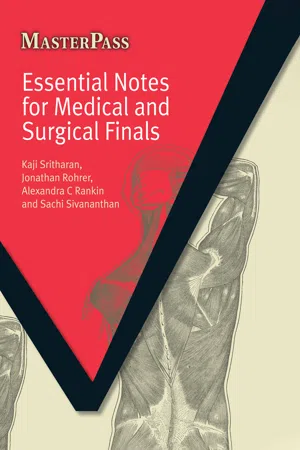
Essential Notes for Medical and Surgical Finals
Kaji Sritharan, Jonathan Rohrer, Alan Rankin, Sachi Sivananthan
- 216 pagine
- English
- ePUB (disponibile sull'app)
- Disponibile su iOS e Android
Essential Notes for Medical and Surgical Finals
Kaji Sritharan, Jonathan Rohrer, Alan Rankin, Sachi Sivananthan
Informazioni sul libro
Covering both medicine and surgery, this book is the essential revision companion for all medical students and a valuable source of knowledge for junior doctors at all stages of their training. It is useful both in the early preparatory phase of revision as well as for last minute cramming, and for use on the wards. This book divides the medical and surgical curricula into over twenty key sections and concisely covers the relevant information for each, including definitions, aetiology, key clinical features, investigations, and management. Examinations for undergraduate medical students and at postgraduate level can take a number of forms, including multiple choice and extended matching questions, single best answers, short notes, vivas and OSCEs. The book provides the necessary information to tackle all these exam formats successfully, as well as to manage each topic competently should it arise in clinical practice. Compact and user-friendly, this book is the ideal revision tool.
Domande frequenti
Informazioni
Medicine
1
Neurology
1.1. Neurological examination
| UMN | LMN | NMJ | MUSCLE | |
|---|---|---|---|---|
| | ||||
| Inspection | Nil | Wasting | Nil | Wasting |
| Fasciculations | ||||
| Tone | Increased | Normal/decreased | Normal | Normal/decreased |
| Weakness (pattern) | Pyramidal | See below | Proximal (fatiguable) | Proximal |
| Reflexes | Increased Extensor plantars | Decreased/absent | Normal | Normal/decreased |
- ‘Pyramidal’ weakness is the pattern seen in UMN syndromes: in the upper limb extensors are weaker than flexors; in the lower limb flexors are weaker than extensors.
- Remember that the UMN synapses with the LMN in the anterior horn of the spinal cord – this will help you remember that in motor neurone disease, a disease of the anterior horn cells, there may be both UMN and LMN signs (although this is not the true explanation!)
- It is useful to think of the LMN as consisting of three parts: the root, the plexus and the nerve. Patterns of weakness then depend on which part is affected. In a polyneuropathy or ‘peripheral neuropathy’ there is commonly distal weakness.
- Peripheral neuropathies: ‘glove and stocking’ distal sensory loss
- Individual nerves: sensory loss over area which nerve supplies
- Plexus or root: sensory loss over dermatome that root supplies
- Spinal cord disease – commonly produces a sensory ‘level’, may:
- affect all modalities (whole cord)
- affect vibration/proprioception only (posterior cord)
- affect pain/temperature only (anterior cord)
- produce dissociated loss, i.e. vibration/proprioception one limb and pain/temperature in the opposite limb (half cord, i.e. Brown-Séquard syndrome)
- Thalamus, internal capsule, sensory cortex: hemisensory loss
1.2. Epilepsy
- Generalised (Tonic-clonic, Absence, Myoclonic).
- Partial (Simple, Complex, Secondary generalised).
Tonic-clonic (‘grand mal’) seizures
Absence (‘petit mal’) seizures
Complex partial seizures
- Diagnosis relies on a good witness history. Examination is generally normal.
- Electroencephalogram (EEG) (interictal EEG is normal in » 50% of cases; if EEG is repeated or sleep EEG performed only » 10% will be normal) and brain CT/MRI.
- Drug therapy: normally started after two clearly described unprovoked seizures. Most patients can be controlled on monotherapy:
- generalised tonic-clonic: first line treatment = valproate, carbamazepine, lamotrigine
- partial: first line treatment = carbamazepine, lamotrigine, valproate.
- General advice to patients.
- Safety measures: take care when bathing/swimming, avoid dangerous sports.
- Driving regulations for unprovoked seizures: the pa...